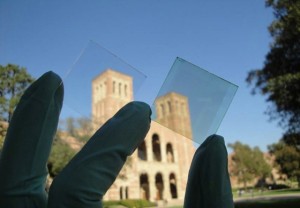
“These results open the potential for visibly transparent polymer solar cells as add-on components of portable electronics, smart windows and building-integrated photovoltaics and in other applications,” said study leader Yang Yang, a UCLA professor of materials science and engineering, who also is director of the Nano Renewable Energy Center at California NanoSystems Institute (CNSI). “Our new PSCs are made from plastic-like materials and are lightweight and flexible. More importantly, they can be produced in high volume at low cost,” he added.
Polymer solar cells have emerged as an attractive alternative to standard silicon cells, due to their lower manufacturing costs and broader range of applications. Previous research met with difficulties in making them transparent or sometimes resulted in low efficiency because there were issues with suitable polymeric PV materials and efficient transparent conductors in terms of design and fabrication.
The UCLA researchers and their associates demonstrated high-performance, solution-processed, visibly transparent polymer solar cells through the incorporation of near-infrared light-sensitive polymer and using silver nanowire composite films as the top transparent electrode. The near-infrared photoactive polymer absorbs more near-infrared light but is less sensitive to visible light, balancing solar cell performance and transparency in the visible wavelength region.
Another breakthrough is the transparent conductor made of a mixture of silver nanowire and titanium dioxide nanoparticles, which was able to replace the opaque metal electrode used in the past. This composite electrode also allows the solar cells to be fabricated economically by solution processing. The combination allowed for a four per cent power-conversion efficiency for solution-processed and visibly transparent polymer solar cells.
Source: UCLA





